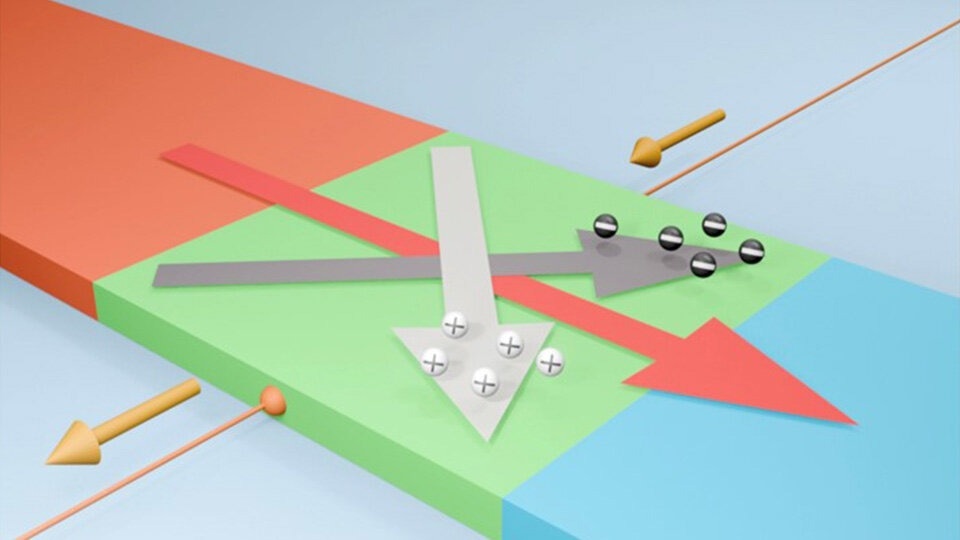Reviewed by Lexie CornerNov 27 2024
Researchers from Tokyo University of Science and Saitama University achieved the transverse thermoelectric effect (TTE) in the semimetal tungsten disilicide (WSi2). Previous research had demonstrated axis-dependent conduction polarity (ADCP) in WSi2, but the source of this effect and the expected TTE had not been identified in earlier trials. The study was published in the journal PRX Energy.
 Transverse thermoelectric generation in WSi2. This paper is the first direct demonstration of the transverse thermoelectric generation in WSi2, and the results could pave the way for more efficient thermoelectric devices. Image credit: Ryuji Okazaki from Tokyo University of Science, Japan
Transverse thermoelectric generation in WSi2. This paper is the first direct demonstration of the transverse thermoelectric generation in WSi2, and the results could pave the way for more efficient thermoelectric devices. Image credit: Ryuji Okazaki from Tokyo University of Science, Japan
Thermoelectric materials can capture and convert waste heat into useful electricity, improving energy efficiency by turning excess heat into power. This is particularly valuable in industries and vehicles with engines that generate significant waste heat.
These materials also hold the potential for portable power generation in satellites and remote sensors where conventional power sources may not be feasible.
In conventional thermoelectric devices, also known as parallel thermoelectric devices, a voltage is generated in the same direction as the heat flow. Typically, two material types—p-type and n-type—are used, producing voltages in opposing directions. When connected in series, these materials can generate a higher voltage. However, more contact points lead to increased electrical resistance, which reduces power output.
In contrast, transverse thermoelectric devices generate electricity perpendicular to the heat flow, allowing for more efficient thermoelectric conversion with fewer connections.
Materials with "ADCP” or goniopolar conductors, which conduct positive charges (p-type) in one direction and negative charges (n-type) in another, are promising candidates for transverse thermoelectric devices. However, direct demonstrations of the TTE have been limited until now.
The team, led by Associate Professor Ryuji Okazaki from the Department of Physics and Astronomy at Tokyo University of Science (TUS), included Mr. Shoya Ohsumi from TUS and Dr. Yoshiki J. Sato from Saitama University.
Transverse thermoelectric conversion is a phenomenon that is gaining attention as a new core technology for sensors capable of measuring temperature and heat flow. However, there are only a limited number of such materials, and no design guidelines have been established. This is the first direct demonstration of the transverse thermoelectric conversion in WSi2.
Ryuji Okazaki, Associate Professor, Tokyo University of Science
The researchers examined the characteristics of WSi2 through a combination of computer models and practical testing. At low temperatures, they studied a WSi2 single crystal's thermopower, electrical resistivity, and thermal conductivity along its two crystallographic axes.
They discovered that WSi2's distinct electronic structure, which includes mixed-dimensional Fermi surfaces, is the source of its ADCP. This structure demonstrates the existence of electrons and holes (positive charge carriers) in distinct dimensions.
A Fermi surface is a hypothesized geometrical surface that divides the occupied and unoccupied electronic states of charge carriers within a solid substance. In WSi2, holes create quasi-two-dimensional Fermi surfaces, and electrons create quasi-one-dimensional ones. The direction-specific conductivity produced by these special Fermi surfaces makes the TTE effect possible.
In line with earlier studies, the researchers also noticed differences in these charge carriers' electrical conductivity between samples. The researchers demonstrated through first-principles simulations that these variances resulted from variations in the way charge carriers scatter due to flaws in the WSi2 crystal lattice structure.
This realization is essential for improving the substance and creating dependable thermoelectric devices. By introducing a temperature differential along a certain angle concerning both crystallographic axes, they also showed direct TTE creation in WSi2, producing a voltage perpendicular to the temperature differential.
Our results indicate that WSi2 is a promising candidate for TTE-based devices. We hope this research will lead to the development of new sensors and the discovery of new transverse thermoelectric materials.
Ryuji Okazaki, Associate Professor, Tokyo University of Science
This work advances the development of new materials that can more effectively convert heat into electricity. It provides insights into the mechanism of TTE generation in WSi2 and contributes to the path toward a greener future.
Journal Reference:
Ohsumi, S., et al. (2024) Transverse Thermoelectric Conversion in the Mixed-Dimensional Semimetal WSi2. PRX Energy. doi.org/10.1103/prxenergy.3.043007.